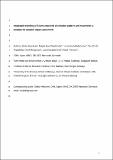Files in this item
Integrated modelling of Atlantic mackerel distribution patterns and movements : a template for dynamic impact assessments
Item metadata
| dc.contributor.author | Heinänen, Stefan | |
| dc.contributor.author | Chudzinska, Magda Ewa | |
| dc.contributor.author | Brandi Mortensen, Jonas | |
| dc.contributor.author | Teo, Theophilus Zhi En | |
| dc.contributor.author | Rong Utne, Kjell | |
| dc.contributor.author | Doksæter Sivle, Lise | |
| dc.contributor.author | Thomsen, Frank | |
| dc.date.accessioned | 2019-09-18T23:37:28Z | |
| dc.date.available | 2019-09-18T23:37:28Z | |
| dc.date.issued | 2018-11-10 | |
| dc.identifier | 256148779 | |
| dc.identifier | 57783a77-06e5-4b25-a6d4-ed1fb4688705 | |
| dc.identifier | 85053446987 | |
| dc.identifier | 000451653800012 | |
| dc.identifier.citation | Heinänen , S , Chudzinska , M E , Brandi Mortensen , J , Teo , T Z E , Rong Utne , K , Doksæter Sivle , L & Thomsen , F 2018 , ' Integrated modelling of Atlantic mackerel distribution patterns and movements : a template for dynamic impact assessments ' , Ecological Modelling , vol. 387 , pp. 118-133 . https://doi.org/10.1016/j.ecolmodel.2018.08.010 | en |
| dc.identifier.issn | 0304-3800 | |
| dc.identifier.other | RIS: urn:7485BA608D2D4C7CD4D72C3598E1BAB8 | |
| dc.identifier.other | ORCID: /0000-0001-9568-1504/work/49140787 | |
| dc.identifier.uri | https://hdl.handle.net/10023/18506 | |
| dc.description | The study was funded by Equinor (formerly Statoil). | en |
| dc.description.abstract | Modelling is important for impact assessments of anthropogenic pressures on wildlife. Models are particularly useful when dealing with complex dynamic systems (as pelagic ecosystems) where data are limited and if various ‘what if’ scenarios should be tested. The aim of this study was to produce and implement an integrated modelling approach, linking high resolution hydrodynamic models (HDM) of the marine environment with correlative species distribution models (SDM) and agent-based models (ABM), for describing the spatio-temporal distribution and movements of Atlantic mackerel (Scomber scombrus) in the Norwegian Sea. The SDM was fitted with scientific mackerel trawl data as response variables (collected in July and August 2006–2014) and temperature (from the HDM), water depth and time period as predictors of spatial distributions. The SDM was able to produce dynamic predictions of a similar order of magnitude as observed catch per unit effort (CPUE) as well as realistic large-scale distribution patterns, when tested on independent data (not included in the modelling). The ABM was calibrated, with normalized SDM predictions (habitat suitability as a proxy for food availability) and hydrodynamics as input and simulated on a single year (2013) for the period May–October, when the migratory mackerel is present in the study area. A pattern-oriented modelling (POM) approach was used to verify if the model reproduced multiple observed real-world patterns. The ABM produced similar patterns as observed regarding migration timing, growth and large scale geographic distribution. Fine scaled information on mackerel movement and behaviour is limited, which is also reflected in the results. More data and knowledge are therefore required to improve the patterns emerging from fine scaled processes. The potential of the model for assessing an impact of a single seismic survey (mimicking a real survey) was finally evaluated. The exercise allowed estimating the number of affected fish (within 50 km from the sound source) and potential changes in local migrations, with the specific assumed minimum sound pressure thresholds (resulting in a fleeing reaction by the mackerel) set to 165 dB re 1 μPa. The model framework was shown to be useful by allowing simulations of impact scenarios in a realistic and dynamic environment. The model can be further updated when data on fine scale movements of mackerel and most importantly when improved data on response behaviour to impacts of sound become available. | |
| dc.format.extent | 16 | |
| dc.format.extent | 270702 | |
| dc.language.iso | eng | |
| dc.relation.ispartof | Ecological Modelling | en |
| dc.subject | Agent based model | en |
| dc.subject | Species distribution model | en |
| dc.subject | Atlantic mackerel | en |
| dc.subject | Migration | en |
| dc.subject | Movement | en |
| dc.subject | Underwater sound | en |
| dc.subject | QH301 Biology | en |
| dc.subject | NDAS | en |
| dc.subject | SDG 14 - Life Below Water | en |
| dc.subject.lcc | QH301 | en |
| dc.title | Integrated modelling of Atlantic mackerel distribution patterns and movements : a template for dynamic impact assessments | en |
| dc.type | Journal article | en |
| dc.contributor.institution | University of St Andrews. Sea Mammal Research Unit | en |
| dc.contributor.institution | University of St Andrews. School of Biology | en |
| dc.contributor.institution | University of St Andrews. Centre for Research into Ecological & Environmental Modelling | en |
| dc.identifier.doi | https://doi.org/10.1016/j.ecolmodel.2018.08.010 | |
| dc.description.status | Peer reviewed | en |
| dc.date.embargoedUntil | 2019-09-19 | |
| dc.identifier.url | https://www.sciencedirect.com/science/article/pii/S0304380018302795?via%3Dihub#sec0110 | en |
This item appears in the following Collection(s)
Items in the St Andrews Research Repository are protected by copyright, with all rights reserved, unless otherwise indicated.

